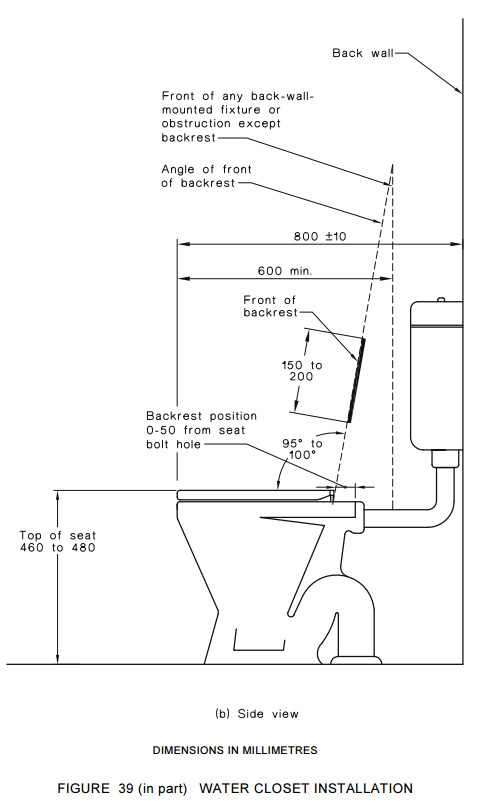Toilets privacy and access for people with disabilities
We are often asked about privacy and line of sight in relation to toilets. This guidance has been prepared to assist in the design of accessible toilet layouts for commercial buildings.
Relevant Building Code performance criteria
The Building Code's G1.3.2 clause requires that sanitary fixtures are located, constructed and installed to:
- provide appropriate privacy
- avoid affecting occupants of adjacent spaces from the presence of unpleasant odours, accumulation of offensive matter or other source of annoyance.
Clause G1.3.4 requires that personal hygiene facilities for people with disabilities are accessible.
The Acceptable Solution G1/AS1 in paragraph 6.0 Privacy contains three components relating to privacy:
- line of sight
- cubicles
- lobbies.
Privacy
The Acceptable Solution contains a simple solution for designers, which is that building users should not be able to see a toilet pan, bidet, shower or bath in the normal use of a building. G1/AS1 achieves privacy by using doors, partitions and changes in direction.

G1/AS1 's Figure 10 a) contains a diagram for visual privacy by a door only.
One door provides adequate privacy between the accessible route and the sanitary compartment containing several fixtures for use by one person at a time. For example:
- toilet and basin
- toilet, basin and shower
- toilet, bidet and basin, shower or bath.
This layout is based on the toilet door being closed when someone is in the compartment and the toilet door closed when the compartment is not being used. The possibility of a person looking past the person leaving the toilet compartment and seeing the WC pan is not considered a likely occurrence.
G1/AS1's Figure 10 b) shows how privacy is achieved by a door on the accessible route and a separating screen within the compartment that can be used by more than one person at a time. Sanitary fixtures within the compartment are separated by cubicles.
G1/AS1's Figure 10 c) and d) gives options of privacy achieved through either:
- a door (on the accessible route) and a screen (within the compartment)
- a screen on the accessible route and a door to the compartment.
Again the compartment can be used by more than one person at a time and the sanitary fixtures within are separated by cubicles.
Specific design solutions for entrances to toilet compartments have been accepted by building consent authorities as complying with the Building Code because their design uses strategic changes in direction to achieve privacy without having a door. Examples may be found at airports where doors would pose problems for people carrying luggage.
The acceptable solution includes guidance on lobbies that building owners and designers may wish to use.
Larger WC pans
Larger accessible compartments, which may contain larger toilet pans, can be specifically designed using Australian Standard AS1428.1:2009 Design for access and mobility - Part 1 General requirements for access.
When installing larger toilet pans, that may have a dimension from the wall to the front of the pan of greater than the dimension range in NZS 4121 and G1/AS1 of 700 to 750mm, a larger compartment is required and this can be achieved by using AS 1428.1:2009 with:
- layout and dimensions complying with clause 15.2.8.1
- an adequate back rest as per Figure 39
- a right angle grab rail as per Figure 42 Option B (the 45 degree angle rail is not used in New Zealand).
Alternatively a larger compartment could be achieved by:
- using Figures in G1/AS1 but having at least 1150mm from the front of the pan which will make the compartment bigger by increasing the 1900mm dimension
- ensuring an adequate back rest as per Figure 39 of AS 1428.1:2009.
These larger toilet pans, with appropriate back rests, can be used in new and altered buildings if installed in a larger toilet compartment.

Pan seat height
The Australian Standard for access for people with disabilities in buildings, AS 1428.1:2009, specifies that the front of the pan is to be a distance of 800 mm from the wall at the rear of the pan. The corresponding dimension in Acceptable Solution G1/AS1 is 700-750 mm. The guidance above notes that, if an Australian pan and pan position is to be used, then the compartment needs to be 50 mm, or more, longer than given in G1/AS1. This layout has the advantage of giving more space for a wheelchair user when making a transfer from alongside the pan.
AS 1428.1:2009 also specifies that the height from the floor to the top of the seat is to be between 460-480 mm. The corresponding dimension in G1/AS1 is 460 mm. We understand that some councils have been unsure whether this height of 460mm is a maximum or a minimum and what tolerance in height is reasonable. For most wheelchair users, a height somewhat greater than 460 mm is preferable to a height of less than 460 mm.
Therefore, in line with AS 1428.1:2009 and G1/AS1, we consider a reasonable tolerance for the height from the floor to the top of the seat to be 460-480 mm.
Accessibility-related determination